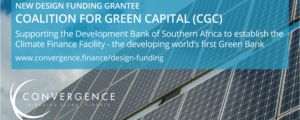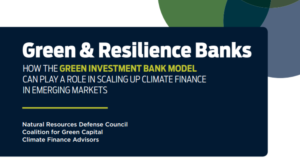The Clean Energy Future Blog
DC Mayor Signs Green Bank Bill
By Coalition for Green Capital


On Tuesday afternoon, Program Director Alex Kragie (center right in photo) represented the Coalition for Green Capital at the bill signing of the Green Finance Authority Establishment Act, which created a Green Bank for the District of Columbia. Mayor Muriel Bowser gave an inspirational talk about our obligations to affect climate action at the local level, given the temporary absence of leadership on the federal level. This DC Green Finance Authority is the latest step in Mayor Bowser’s celebrated efforts to make DC a national leader on climate issues.
Alex writes:
It was tremendously gratifying to see a project that the Coalition for Green Capital has been involved with since inception come to fruition. The DC Green Finance Authority is now in a position to reduce carbon emissions while simultaneously creating jobs and economic activity throughout DC. The Coalition for Green Capital, with our partners at the District Department of Energy and Environment, wrote the initial report that spurred the creation of the Green Finance Authority Establishment Act, and we advised the government throughout the lead up to this momentous day. We look forward to continuing to work together with the DC Green Finance Authority to continue DC’s national leadership position on clean energy.
By Coalition for Green Capital

TORONTO, 5 April 2018 – Convergence and ClimateWorks are partnering with the Coalition for Green Capital (CGC) and the Development Bank of Southern Africa (DBSA) to support the establishment of the Climate Finance Facility (CFF), which hopes to be the first “Green Bank” in an emerging market.
The CFF will rapidly scale up private investments in climate-friendly infrastructure projects in the Southern African Development Community (SADC) region, which faces significant climate mitigation and adaptation challenges. Currently, electricity generation is still 90% fossil fuel based and over 50% of people have no access to electricity. The region needs clean energy solutions that reduce energy costs, expand access, increase reliability, lower emissions, and support socio-economic development.
 “Clean power and water are the lifeblood of economic growth and should be abundant and affordable across the developing world,” notes Reed Hundt, CEO of CGC. “Achieving climate investment goals, however, requires a massive surge in private sector-led spending on low-carbon infrastructure. The Climate Finance Facility is designed to meet this need with a mandate to crowd in private investment in green infrastructure.”
“Clean power and water are the lifeblood of economic growth and should be abundant and affordable across the developing world,” notes Reed Hundt, CEO of CGC. “Achieving climate investment goals, however, requires a massive surge in private sector-led spending on low-carbon infrastructure. The Climate Finance Facility is designed to meet this need with a mandate to crowd in private investment in green infrastructure.”
A lack of affordable financing has been a key barrier to the rapid deployment of climate-friendly projects, such as those in the renewable energy and water sectors. The CFF will address market barriers by co-financing projects with local commercial banks through subordinated debt / first loss positions, and providing credit enhancements primarily in the form of tenor extension to crowd in private capital. The CFF will initially target Rand-based economies countries connected to the Southern Africa Power Pool (SAPP), such as South Africa, Namibia, Lesotho, and Swaziland.
The CFF will be a unique application of the Green Bank model, adapted for emerging markets conditions. Rather than establish a new standalone institution, the standard in developed markets, the CFF will be a self-sustaining and distinct entity within the DBSA, with its own balance sheet and dedicated operations.
“Green banks have shown they can catalyze the market for low-carbon, resilient infrastructure innovations. ClimateWorks is delighted to support work by CGC and South African partners in the race to pioneer the model in an emerging economy,” says Ilmi Granoff, Director of Sustainable Finance at ClimateWorks.
Convergence awarded a Design Funding grant to CGC to support the DBSA with critical business planning, institutional design, financial product support, capitalization and operationalization of the CFF. The Government of Canada provided funding for Convergence’s Design Funding to pilot new blended finance vehicles that aim to catalyze private capital at scale for sustainable development.
“The CFF is globally significant,” says Joan Larrea, CEO of Convergence. “Its establishment will be a model for middle and lower income countries on how market barriers can be addressed in the climate sector and draw in private investment through blended finance. By supporting CGC and DBSA, we hope they pave the way for more institutions to replicate the CFF structure throughout the developing world.”
There has been strong support and interest from stakeholders to date for the CFF, including from the South African Department of Environmental Affairs, the Green Climate Fund, as well as several major commercial banks and development finance institutions in the region.
ABOUT CONVERGENCE
Convergence is the global network for blended finance. We generate blended finance data, intelligence, and deal flow to increase private sector investment in developing countries.
Convergence accepts Design Funding applications on a continuous basis, and reviews applications every quarter. To be considered for the next review cycle, practitioners must submit their applications by May 31, 2018. Find out more here.
ABOUT CLIMATEWORKS
ClimateWorks Foundation is a team of researchers, strategists, collaborators, and grant-makers who are committed to climate action and believe in the power of collective philanthropy. A non-governmental organization that works globally, ClimateWorks collaborates with funders, regional and research partners, and other climate leaders to strengthen philanthropy’s response to climate change.
ABOUT CGC
The Coalition for Green Capital (CGC) is a non-profit organization focused on accelerating the growth of clean energy markets through the creation of Green Banks.
CGC offers a unique and proven capacity as the leading creator, advocate, and expert on Green Banks since 2009 and works directly to support the formation of Green Banks with governmental and civil society partners, and provide on-going consulting and guidance to operating Green Banks.
ABOUT DBSA
The Development Bank of Southern Africa (DBSA) is a leading development finance institution working across the African continent. Established in 1983, our purpose is to promote economic and social development, growth and regional integration through infrastructure finance and development.
The DBSA plays a catalytic role in delivering infrastructure in the energy, transport, water and telecommunications sectors, with a secondary focus on health and education. We operate across the infrastructure value chain from planning, preparation, and financing to implementation, delivery and maintenance.
At the core of our business, is our vision of a prosperous region, free from poverty. Our mission is to support economic growth through investment in economic infrastructure and improve the quality of life for all, through the development of social infrastructure.
By Coalition for Green Capital

Coalition for Green Capital, NRDC and Climate Finance Advisors released a new policy working paper on potential of Green Banks to drive investments needed to meet the goals of the Paris Agreement.
MARRAKECH (November 14, 2016) – Leaders in global green investment today released a policy working paper, Green & Resilience Banks: How the Green Investment Bank Model Can Play a Role in Scaling Up Climate Finance in Emerging Markets, at an official side event of the 22nd Conference of the Parties (COP22) to the United Nations Framework Convention on Climate Change in Marrakech, Morocco.
The paper, authored by the Coalition For Green Capital, the Natural Resources Defense Council and Climate Finance Advisors, shows how Green Investment Banks are succeeding in countries such as Japan, the United Kingdom, Malaysia, Australia and the United States. Green Investment Banks are specialized public financing authorities set up to persuade private investors to increase and accelerate their investment in renewable energy and energy efficiency.
The paper also explores the potential of the Green Investment Bank model in emerging and developing economies. Emerging markets will need to leverage both public and private investment to address climate change. The paper notes that around the world, significant amounts of capital will be needed to finance the clean energy and other infrastructure projects required to meet the climate change mitigation and adaptation objectives of the Paris Agreement. Most of this financing will have to come from private sources. By some estimates, the required investment in sustainable infrastructure globally is up to $6 trillion per year, or $90 trillion by 2030. These investments can also contribute to the United Nations Sustainable Development Goals, including those focused on increasing access to sustainable energy.
Existing green investment banks are showing success. As reported in the paper, after only a few short years of operation, existing Green Investment Bank institutions have mobilized US$22 billion in private capital by committing or investing only $6.2 billion of public money. The paper highlights how Green Investment Banks are well placed to make effective and efficient use of climate funds from international facilities such as the Green Climate Fund, the Global Environment Facility and the Climate Investment Funds.
In emerging and developing economies, Green Investment Banks could make a difference in countries’ efforts in achieving the climate goals articulated in their commitments under the Paris Agreement, serve as a locus of financial innovation in local markets, and blend and coordinate investments by diverse public, private, international and domestic investors.
Jeff Schub, Executive Director of the Coalition for Green Capital, said, “This report lays out what could be a powerful institutional framework for driving climate investment. Green Investment Banks have already proven themselves a successful model for increased public and private investment in clean energy. CGC believes that the model can be adapted for new markets and play a critical role in building local institutional capacity. By tapping into international and domestic capital, national Green Investment Banks could accelerate achievement of climate targets.”
Doug Sims, Director of Strategy and Finance for NRDC’s Center for Market Innovation said, “Green Investment Banks have a growing track record in mobilizing the billions for clean and resilient infrastructure and that needs to grow to trillions. The model of an institution with special skills and a narrow mandate to increase investment can be readily adapted to the challenges of developing and emerging economies.”
Stacy Swann, CEO of Climate Finance Advisors said, “In emerging markets, the Green Investment Bank model has the potential to fill a unique financing need that exists between international sources of finance and local project. Operating locally, with a focused mandate on scaling up climate-smart investments, GIBs can complement and help accelerate financing that can support sustainable, resilient investment where it matters.”
About the Coalition for Green Capital
The Coalition for Green Capital is a non-profit organization that helps states and nation-states to create and run financing institutions aimed at increasing public-private investment in the new clean power platform. Founded by Reed Hundt and Ken Berlin in 2009, CGC now has the support of major environmental foundations and is working in more than a dozen states in the United States as well as at the international level. For more information, contact Executive Director Jeffrey Schub, at jeff@cgcstagingsite.wpengine.com
About the Natural Resources Defense Council
The Natural Resources Defense Council (NRDC) is an international nonprofit environmental organization with more than 2 million members and online activists. Since 1970, our lawyers, scientists, and other environmental specialists have worked to protect the world’s natural resources, public health, and the environment. NRDC has offices in New York City; Washington, D.C.; Los Angeles; San Francisco; Chicago; Bozeman, Montana; and Beijing. Visit us at www.nrdc.org and follow us on Twitter @NRDC. For more information, contact Doug Sims at dsims@nrdc.org
About Climate Finance Advisors
Climate Finance Advisors is an advisory and consulting firm in the Washington DC area that works with public policy makers at the national and international level, as well as investors, bankers, fund managers, and project developers on issues related to climate finance, green banks and funds, and climate risk. Founded in 2015, Climate Finance Advisors has expertise in blended finance and development finance, and in structuring sustainable, resilient and climate smart investments. For more information, contact Stacy A. Swann at sswann@climate-fa.com
A Green Bank for the Garden State
By Coalition for Green Capital


The Market Opportunity
The report finds that NJ has a $40 billion investment opportunity in solar PV alone. In addition, the state has an untapped market for offshore wind and far deeper energy efficiency savings to be realized. These three technologies can support a clean energy economy in NJ. Today, NJ relies on nuclear power for electricity, natural gas for electricity and heating, and oil for transportation. But with nuclear plants preparing to close, base load must quickly be replaced by renewables to avoid greater dependence on natural gas.
Accelerating deployment of clean energy technology requires more investment to pay for the upfront cost. There isn’t enough public capital to pay for the investment, but private capital is not streaming at the scale and ease that is needed. Strategic and innovative use of limited public funds can spark private investment, and support new clean energy infrastructure and economic growth in the state.
New Finance Capacity is Needed
Though NJ has a number of programs and institutions meant to provide clean energy rebates, or financing for related infrastructure markets, there is no dedicated capacity and funding for clean energy project finance. This report outlines three options:
- Create a ring-fenced clean energy unit within the Governor’s proposed State Bank;
- Expand the authority of the state’s Infrastructure Bank (currently the Environmental Infrastructure Trust) to include clean energy; or
- Create a new stand-alone Green Bank, modeled on those used by neighboring states like New York and Connecticut.
The report explores these options and evaluates the pros and cons of each. In addition, the report describes the specific financing mechanisms and innovative tools, like commercial PACE and Environmental Impact Bonds, that could be deployed through a financing institution. New financing programs can also be tailored to address underserved communities that are often unable to access cleaner and cheaper energy.
NJ and Governor-elect Murphy have a perfect opportunity to make clean energy a focal point for a growing economy with modern infrastructure. It can learn from the best practices of Green Banks and related entities from around the country, including from right across the Hudson River. Whether with a new Green Bank or expansion of what already exists, NJ can tap a multi-billion-dollar clean energy market with smart use of public capital and innovative financing.
NY Green Bank’s Path to Profitability
By Coalition for Green Capital
Earlier this year, NY Green Bank reported that it was profitable for the first time in its history. This is a critical moment in the development of NY Green Bank, and an important marker in the Green Bank movement more broadly. NY Green Bank is the first Green Bank in the U.S. to generate positive net income, meaning the revenue earned on its finance activity is greater than the operating costs of running the organization. This demonstrates that Green Banks can be self-sustaining operations. By reaching profitability, NY Green Bank is successfully preserving ratepayer dollars while proving out the attractive investment opportunity in the state’s clean energy markets.
What makes this accomplishment even more impressive is that the organization reached this milestone of success one year ahead of schedule. As reported in the FY 2017 Financial Statements for the period ending March 31, 2017, the organization finished the year with $9.7 million in revenue against $7.0 million in expenses for a net profit of $2.7 million. This financial success didn’t happen by accident. It was achieved through careful financial planning and an organizational growth plan laid out from the very inception of the Green Bank in 2013.
When capitalization was first approved for NY Green Bank by the New York Public Service Commission in late 2013, the order very specifically limited how much money could be used for operating expenses. Of the initial funds allocated to NY Green Bank, 8%, or $17.48 million, could be used for start-up and initial operating costs. (An additional $4 million was allowed for program evaluation costs.) The order stated that “once the Green Bank is fully capitalized and operational, [NYSERDA] expects the Green Bank administrative costs to be covered by customer fees and investment earnings collected by the Green Bank.”
This limit on operating expenses was confirmed in following orders that provided increased capitalization to the Bank, but specifically did not allow any of those funds to be used for operations. This meant that NY Green Bank must reach a point of profitable operations before exhausting the funds available to cover start-up costs. In NY Green Bank’s filings, it targeted March 31, 2018 as the date by which it would be generating net income on an annual basis (NY Green Bank’s financial year runs April 1 through March 31).
 Because of a tremendous effort in the past year that saw NY Green Bank grow its portfolio by almost $300 million – well in excess of the targeted $200 million – NY Green Bank was able to hit the target in FY 2017, one year ahead of schedule. Through June 30, 2017, the Bank has invested $409.4 million to support projects with a total cost of between $1.2 and $1.4 billion.
Because of a tremendous effort in the past year that saw NY Green Bank grow its portfolio by almost $300 million – well in excess of the targeted $200 million – NY Green Bank was able to hit the target in FY 2017, one year ahead of schedule. Through June 30, 2017, the Bank has invested $409.4 million to support projects with a total cost of between $1.2 and $1.4 billion.
This pathway to profitability can serve as a model for all new Green Banks and related clean energy finance entities. NY Green Bank has shown how to provide catalytic finance for clean energy market growth while preserving public capital and generating a return for ratepayers. This careful financial planning and business management can be replicated to ensure other Green Banks around the world reach profitability in a prudent time frame. And, perhaps even more importantly, NY Green Bank’s operational success demonstrates to private investors that they, too, can make good returns on their money by investing in underserved parts of the clean energy markets.
On the Road to a South African Green Bank
By Coalition for Green Capital

Jonathan First, DBSA; Andrea Colnes, CGC; Rob Youngs, CGC; Jeff Schub, CGC and Olympus Manthata, DBSA
CGC staff spent the last week in Johannesburg, partnering with the Development Bank of Southern Africa (DBSA) on the formation of their new Climate Finance Unit based on a “Green Bank” model. The DBSA is a regional development bank, financing infrastructure projects across multiple countries in partnership with private lenders and international DFIs. Identifying the opportunity and the need to increase its “green” development activity, the DBSA has decided to form a Climate Finance Unit (CFU) dedicated to financing climate-friendly infrastructure across energy, water and other key sectors.
Like other Green Banks before it, the CFU will focus on filling market gaps and offering capital in ways that can catalyze greater private investment. It will specifically support projects that are commercial but not quite “bankable” for the private lenders, and would benefit from the CFU’s credit enhancing capital. The DBSA is also taking an innovative approach to technical assistance, as the CFU will reside within its broader Project Preparation Unit. This will allow the DBSA to provide both development and capital support to projects.
The DBSA is now in the process of securing co-funders to support the new Climate Finance Facility, which will be the primary lending vehicle for the CFU. This debt facility will be seeded by the DBSA itself, but it is also seeking co-funding from DFIs and potentially the Green Climate Fund, as well. The Facility will make debt and credit enhancing forms of investments. And DBSA will source financial product concepts from a new Climate Policy Initiative “Lab,” which will be co-located within the DBSA’s facilities.
This is a significant development in climate finance, and not just for Southern Africa. Coming out of Paris Agreement, attention has shifted to the country level, where local implementers must figure out how they will pay for low-carbon infrastructure. CGC recently completed a large research and stakeholder outreach project, funded by the Hewlett Foundation, to explore the application of the Green Bank model in emerging and developing markets. This work indicated that Green Banks can become a key piece of the climate finance architecture, driving more foreign and domestic climate investment, while enabling local actors to determine climate investment needs.
The DBSA’s leadership and desire to implement this innovative model serves as an example for developing countries around the world. For national development banks curious to know how they can form defined Green Bank divisions within their existing institution, South Africa is showing in a practical way how this can be done. By engaging and hopefully pulling in investments from DFIs, they are also creating a precedent for new ways that foreign development capital can flow into local markets and be highly catalytic, driving increased levels of private investment in new market segments.
There is still much work to be done to launch South Africa’s new Green Bank, but they are on their way. And CGC is proud to be partnering with the DBSA on its work, delivering technical know-how and Green Bank best practices from around the world.
Follow
The Clean Energy Future Blog
for links, analysis, and commentary on the world of green banks and clean energy investment

